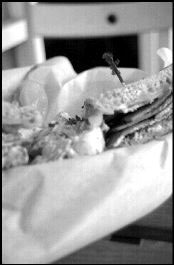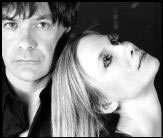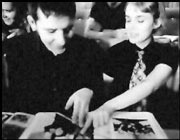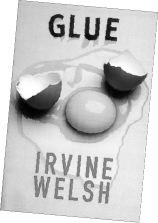Throughout my junior-high and high-school career, dog-eared copies of the Jim Morrison biography No One Here Gets Out Alive (Mass Market, $7.99) were passed from backpack to backpack—often by kids otherwise allergic to books—the stories of debauchery within spread with even more enthusiasm through the oral tradition. I imagine Kurt Cobain read the book; it seems that most dead icons were somewhat obsessed with the preceding generation’s dead icons. You needn’t be a tragic figure, of course, to see the vicarious appeal of such a book. Death and celebrity—especially in combination with good old sex, drugs, and rock ‘n’ roll—have timeless appeal.
If current bestseller lists are any indication, lots of fans this holiday season will be unwrapping copies of Kurt Cobain’s Journals (Riverhead, $29.95), a most welcome addition to the dead rocker canon. Journals is a rather handsome volume, but the greater charm is in its lack of organization or annotation—perfect for personal interpretation, however faulty.
As a public service, I’ve recently gorged myself on several other scribblings of and about notable dead rockers. Sticking first with Kurt, keep Charles Cross’ Heavier Than Heaven (Hyperion, $14.95) in mind. Those who find explication of the Journals too disorienting will appreciate Cross’ liberal use of those materials in his biography. Only time will tell if Heavier is the definitive story—if there really is such a thing—but it’s certainly a compelling read.
Tony Fletcher’s Moon (HarperEntertainment, $18) is similar in its meticulous reporting and the pervading sense that his subject was doomed from the start. Unlike Kurt, though, Keith Moon was less a tormented soul than a tireless madman. Moon at least seemed to have lots of fun and— assuming you weren’t sitting near him on an airplane or staying in the same hotel—was endlessly entertaining (if exhausting) to others. At nearly 600 pages, Moon is a commitment, but the drummer’s shenanigans and Fletcher’s thoughtful rendering of his private persona make the task worthwhile.
Gram Parsons (a member of the 27-year-old club along with Cobain, Morrison, Hendrix, and Joplin) is the subject of Ben Fong-Torres’ Hickory Wind (St. Martin’s Griffin, $13.95), another well- researched, well-written bio. While respectful of Parsons’ legacy, a rather refreshing aspect of Fong-Torres’ analysis is that he avoids the common temptation to which biographers of fallen young subjects have succumbed of intimating the grand heights that would have been achieved if death could have been postponed—he rather bluntly proposes that the spoiled, dilettantish Parsons probably wouldn’t have amounted to much more had he lived longer.
Speaking of dilettantes, the Rolling Stones’ shimmering Brian Jones gets weirdly short-shrifted in Jeremy Reed’s The Last Decadent (Creation, $17.95), which reads more like an overlong grad school paper than a rock bio. Reed’s thesis that the dandy Jones followed in the flamboyant footsteps of Lord Byron, Oscar Wilde, and Quentin Crisp is fine, but precious little else is presented here (Reed, it seems, had nary an inside source).
Joy Division’s Ian Curtis, who didn’t even make it to 27 (how cool is that, kids!), remains inscrutable even after the account his wife Deborah offers in Touching From a Distance (Faber and Faber, $15.63). The Mrs. isn’t a professional writer, yet worse than her prose is her lack of knowledge about the particulars of her husband’s creative process and personality. She doesn’t seem to be holding back—it simply seems that she didn’t know him very well. Someone needs to take another crack at capturing Curtis.
Unlike his interminable guitar parts and his pokey surrender to his demons, Jerry Garcia’s latest volume, Amazing Grace (HarperCollins, $15.95) is a terse little number featuring his artwork adorning the lyrics to the title song—which is just fine for fans, though the illustrations remind me far too much of some horrifying Garcia-brand neckties given to me as gifts by some rather thoughtless relations. A CD featuring Garcia and David Grisman’s rendering of the old standard is included.
Merri Cyr’s photo memoir of Jeff Buckley, A Wished-For Song (Hal Leonard, $30), is perhaps the easiest pill to swallow (or river to drown in, as it were). The gauzy photos make Buckley look positively spectral; even those not totally taken with Buckley’s music can enjoy the treatment. He was a photogenic figure for sure, both in pouty posed shots and more unguarded moments. Interviews with friends, which focus mostly on his art and generally avoid the circumstances of his death, provide the accompanying text—a fine coffee table selection.
Finally, George Harrison’s I Me Mine (Chronicle, $24.95), originally published in 1980, received a recent posthumous reissue, but save for a new foreword there’s nothing new in this rather reclusive autobiography (biggest revelation: Harrison really, really didn’t like air travel). Like its subject, I Me Mine has a regal air, but that’s not really very rock ‘n’ roll, now is it?









